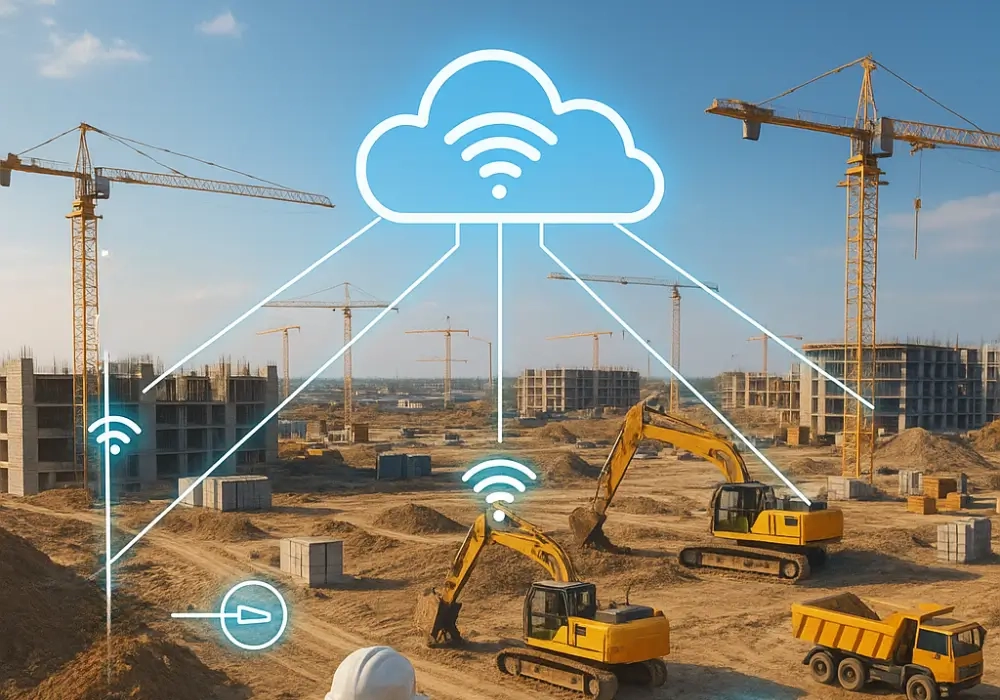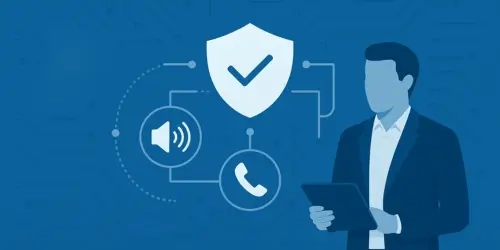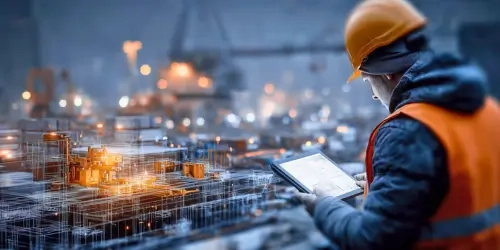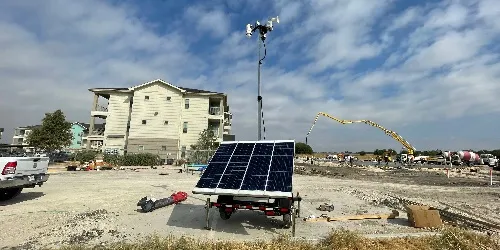Construction has always been a boots-on-the-ground industry, but the workplace has changed dramatically. Today, one team might be installing cameras on-site while safety officers review compliance reports from their home or office.
That shift gives construction companies more flexibility, but it also creates new blind spots. Data lives in more places, and people log in from more devices. Safety oversight, once as simple as a daily walk-around, now happens through screens and sensors run by IT managers.
This article explores the shifting pressures faced by IT leaders as the construction industry goes hybrid and how cloud-based safety platforms, mobile surveillance, and smart detection systems can help them stay in control of every jobsite, no matter the location.
The Reality of Hybrid and Construction Work
Hybrid construction work doesn’t look like a corporate hybrid model. Instead of desks and laptops, it’s a mix of workers on active jobsites, supervisors managing construction projects remotely, and engineers collaborating from offices or home. Each role relies on technology, yet not everyone is connected to the same systems.
That fragmentation brings risk:
-
Safety updates can lag.
-
Different jobsites might use different tools.
-
Compliance data may live in multiple systems that don’t talk to each other.
-
Communication gaps leave people out of the loop.
When every jobsite runs a little differently, construction oversight becomes scattered, and IT managers are the ones who see this first hand. They’re trying to connect data that was never designed to flow together, and too often, safety monitoring becomes about reacting to problems instead of preventing them.
The IT Manager’s Expanding Role in Construction Safety
Several years ago, construction jobsite security focused on network uptime and data storage. Now, they are also responsible for protecting people in the field. Hybrid operations mean every system, from mobile surveillance to environmental sensors, depends on IT infrastructure to function safely and securely.
Here’s what that looks like in practice:
- Managing secure access for teams spread across multiple locations.
- Building reliable connections between surveillance systems and cloud dashboards.
- Consolidating tools so teams don't switch between separate apps for surveillance, reporting, and compliance.
As construction project management grows more connected, safety becomes a shared responsibility between IT and jobsite management. IT leaders are now decision-makers in how safety data in the construction companies is collected and acted upon.
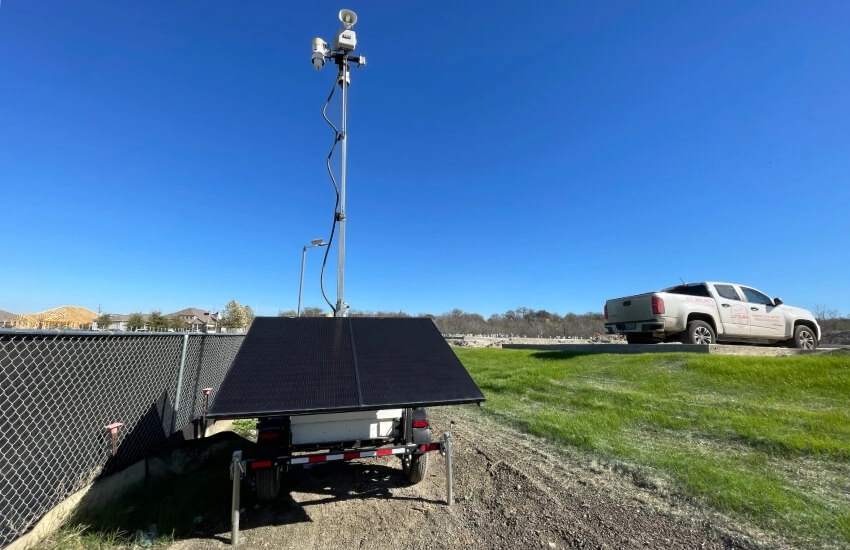
Cloud-Based Safety Platforms: The Foundation for Hybrid and Remote Oversight
When teams split between field and office work, visibility often suffers first. On-site supervisors might see one version of events, while remote work engineers and safety officers work with outdated data. Cloud-based platforms change the game by connecting every jobsite, no matter how remote, into one network.
Instead of each jobsite running its own tools, IT managers can create a single digital environment where video, compliance data, and sensor readings sync automatically. Everyone, whether they’re behind a screen or on the jobsite, works from the same live information.
Stellifii: Cloud Oversight in Action
Stellifii is our cloud-based platform built for modern construction oversight. Developed in-house, it combines security hardware, AI analytics, and environmental monitoring in one cloud system. For IT managers, that means total control and visibility across hybrid and fully remote work.
Here's how Stelliffii supports IT managers facing hybrid and remote work safety challenges:
| Hybrid & Remote Work Safety Challenge | How Stellifii Supports IT Managers |
| Fragmented oversight between remote work and on-site teams. | Cloud dashboards unify live video, sensor data, and compliance logs for all project management. |
| Manual audits and inconsistent reporting. | Automated reports cover safety, air quality, noise, and PPE compliance (all exportable on demand). |
| Multiple tools for safety, security, and monitoring (tool sprawl). | One login for surveillance, condition monitoring, diagnostics, and analytics. |
| Slow reactions when incidents occur. | Real-time alerts, AI-based detection, and smart search help remote teams act immediately. |
| Rising infrastructure and maintenance costs. | Cloud access removes the need for on-site servers and manual retrieval, cutting IT workload. |
With Stellifii, compliance in the construction industry doesn’t depend on being on-site. IT managers can track safety metrics and pull audit reports from anywhere. Cloud-based infrastructure removes the cost of physical hardware and simplifies updates, giving teams full oversight and faster access to the data that keeps every project compliant and safe.
From Surveillance to Smart Detection: Building a Connected Safety Network
When construction projects cover dozens of miles or include multiple active jobsites, keeping everyone informed becomes a real challenge. IT managers know this better than anyone. A camera outage or a missed alert can leave a blind spot right where safety matters most.
Bringing Remote Work Jobsites Into View
Not every jobsite comes with power or stable Wi-Fi. Some are deep in rural areas, others shift weekly as projects move along. Solar-powered surveillance trailers close that gap. They are fully self-sufficient thanks to solar panels, battery backup, and cellular connectivity. This is everything an IT manager needs to be able to deploy monitoring within hours instead of days.
Pole cameras, on the other hand, fit better in compact or urban jobsites. They can be relocated as layouts change, offering flexibility that fixed systems can’t. Both solutions feed live video and environmental data straight into Stellifii so IT teams can see what’s happening, check system health, and receive alerts from a single dashboard.
Turning Footage Into Actionable Data
The next step is intelligence, helping IT managers understand what those cameras are seeing. Smart detection systems handle this job.
PPE detection identifies when helmets or vests are missing and creates a digital record that’s ready for audits. Smoke and fire detection adds another layer of protection by catching visual cues that traditional sensors might miss, especially on unmanned or off-grid jobsites. Intrusion detection rounds out the trio, filtering false alarms from weather or wildlife while monitoring sensitive zones after hours.
Environmental Monitoring: Seeing Beyond the Visual
Environmental monitoring solutions help construction companies track the invisible risks. Air quality sensors, noise meters, and weather stations feed live data into the same Stellifii dashboard used for video and smart detection. That means no matter where your team is, everyone sees the same real-time picture.
Air quality monitoring tracks particulates (PM1, PM2.5, PM10, and CO₂ levels), sending alerts when thresholds are exceeded. Noise monitoring is another critical piece of the puzzle, especially on jobsites near residential areas or sensitive zones. Continuous tracking prevents violations before they escalate into complaints or fines.
Weather monitoring closes the loop. Wind, rain, lightning, and extreme heat aren’t abstract hazards. They affect schedules and outdoor operations. Knowing conditions in real time allows IT managers and jobsite supervisors to adjust operations proactively rather than reactively.
Integrating Systems for Full Visibility and Control
With a unified platform like Stellifii, IT teams get one interface for live feeds, alerts, compliance logs, and environmental data. Hybrid teams on-site can act on alerts the moment they appear, while remote work supervisors have full visibility without ever setting foot on the jobsite.
Some of the key advantages include:
-
Faster response times across all locations.
-
Reduced manual oversight and less tool switching.
-
Complete audit trails for compliance and reporting.
-
Insights into recurring hazards for preventive safety measures.
By connecting all these systems, IT managers can see what’s happening at all times and, just as importantly, analyze trends over weeks or months, using both real-time and historical data to make informed decisions that protect people and projects now, and plan more safely for the future.
Take Control of Hybrid and Remote Construction Safety
Managing construction safety across hybrid and remote work teams doesn’t have to be chaotic. With WCCTV’s integrated security solutions all backed by the Stellifii platform, IT managers gain a single source of truth. Hybrid crews stay informed on-site, and remote supervisors never miss a critical event, supported by systems designed to work together under one secure network.
Ready to take the next step? Contact WCCTV to centralize your jobsite safety operations and give your teams the visibility and control they need.
FAQs
How can IT managers support workplace safety in remote or hybrid work environments?
By combining cloud platforms with environmental monitoring tools and smart detection systems, IT managers can monitor jobsite conditions and safety compliance from anywhere. These digital tools help maintain accountability and protect both on-site and remote employees without requiring constant physical presence.
What role does project management software play in remote and hybrid construction teams?
Project management software allows hybrid work models to stay organized and transparent. It helps remote teams track task completion, manage project timelines, and coordinate safety protocols. When integrated with safety programs and surveillance systems, it ensures that work progress and compliance go hand in hand.
How do digital tools improve communication and accountability for remote workers?
With real-time communication features, virtual meetings, and automated reporting, digital tools let safety managers and supervisors oversee projects even when teams are working remotely. They can share updates instantly and maintain a consistent safety culture across all jobsites.
How does remote access to safety and compliance data benefit IT managers?
Remote access gives IT managers immediate visibility into jobsite operations and data security metrics. Whether reviewing environmental readings, system alerts, or compliance reports, they can respond faster and make informed decisions that keep remote and hybrid teams safe, efficient, and aligned.
